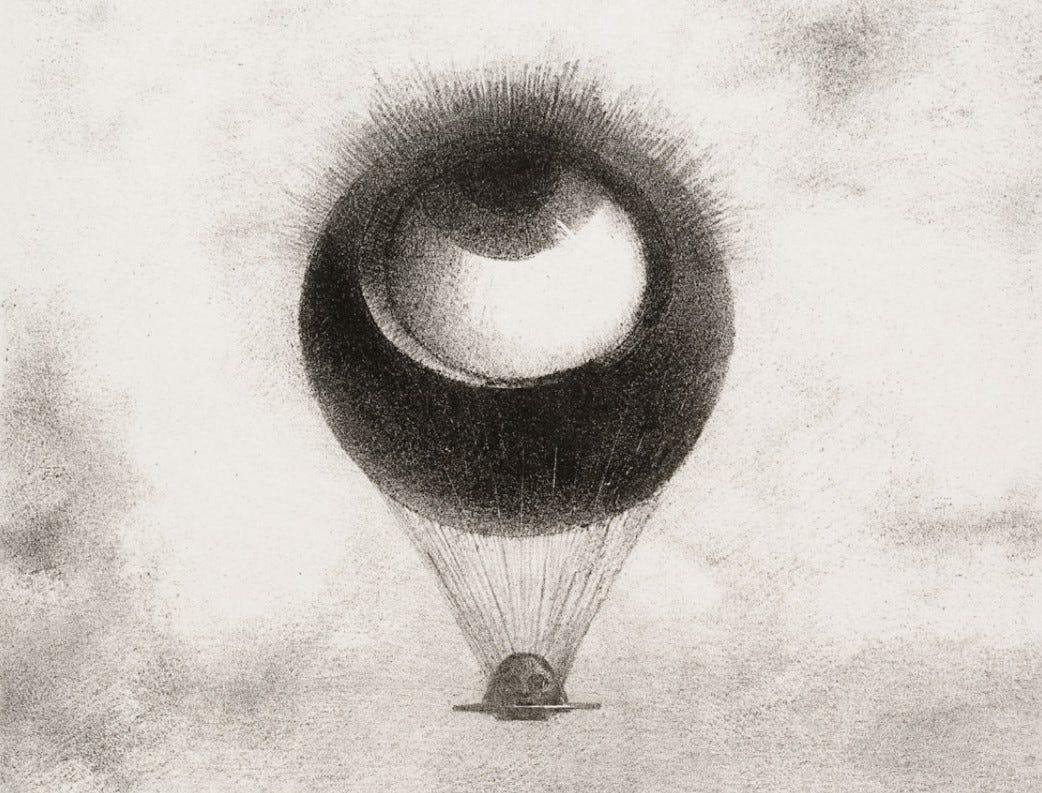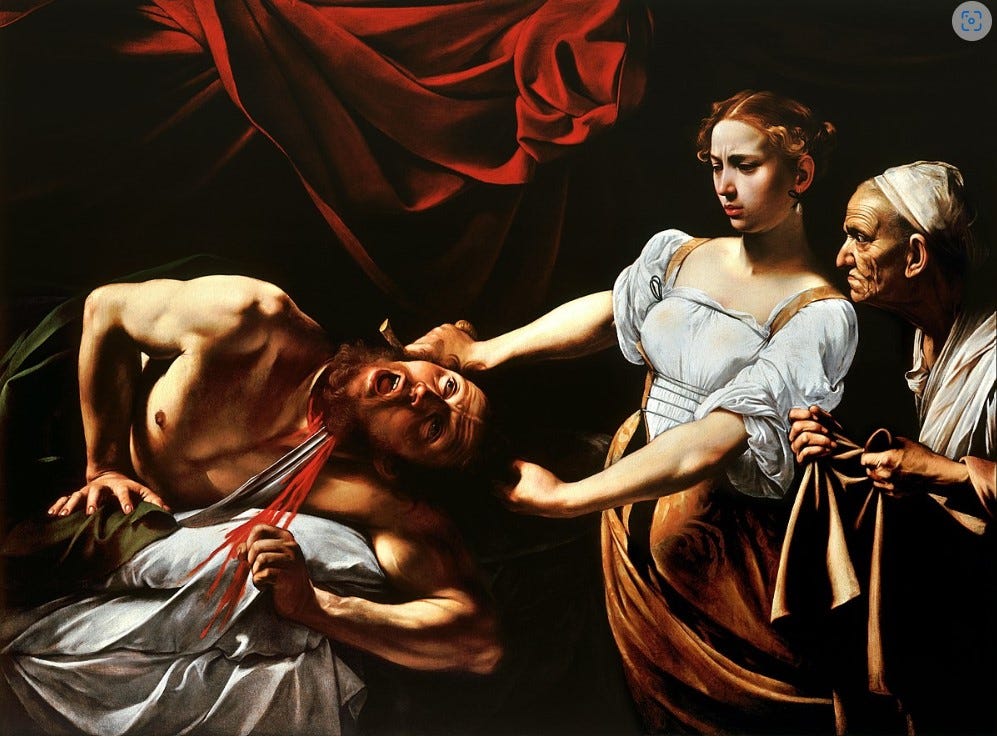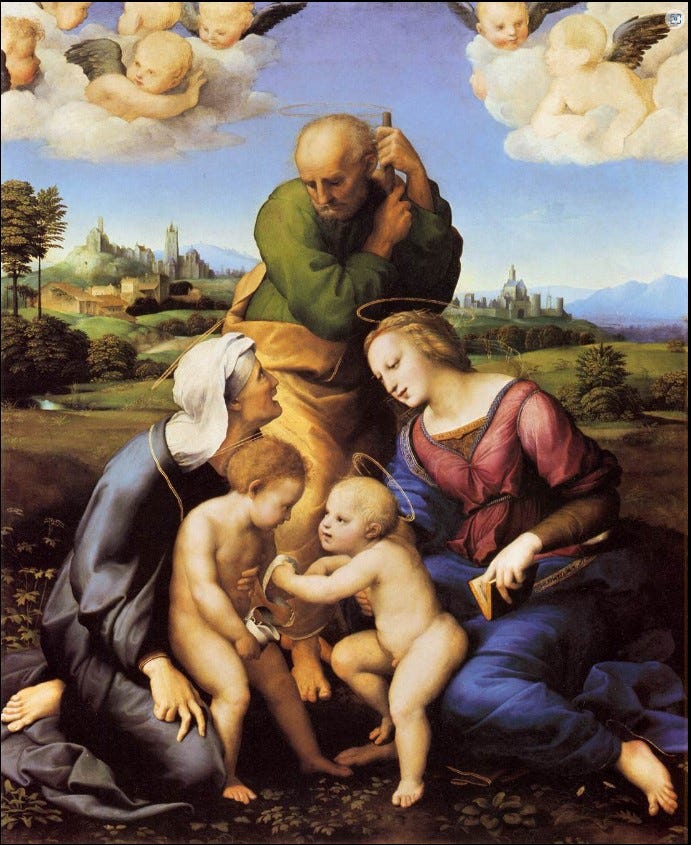Exhibit One is a quotation from the artist Odilon Redon:
“My drawings are not intended to define anything; they inspire. They make no statements and set no limits. They lead, like music, into an ambiguous world where there is no cause and no effect.”
Before reading this, I hadn’t thought much about cause and effect in art—how, for example, certain Impressionist paintings present sunlight and leaves as a cause and dappling as the effect. Or how, in Caravaggio’s Judith Beheading Holofernes, 1599, the cause is Judith’s sword and the effect is the spurting blood of the king. When we think of our responses to artworks, cause and effect of another sort comes into focus. Say you like a certain sunny Impressionist landscape. The painting, in that case, serves as a cause and your pleasure is the effect. If Judith Beheading Holofernes is the cause, then the nature of the effect depends on your taste for blood-soaked theatrics.
And there is cause and effect of still another, more elusive kind in every work of art. To get at this, I’ll introduce Exhibit Two, a passage from “Why I Am Not a Painter,” 1956, a poem by Frank O’Hara. It begins with a declaration of the obvious and proceeds from there:
I am not a painter, I am a poet.
Why? I think I would rather be
a painter, but I am not. Well,
for instance, Mike Goldberg
is starting a painting. I drop in.
“Sit down and have a drink” he
says. I drink; we drink. I look
up. “You have SARDINES in it.”
“Yes, it needed something there.”
Remarking on the word SARDINES in Goldberg’s painting, O’Hara implies a question: why did you include that? The painter’s answer, “it needed something there,” implies that he made the addition because there was an emptiness to be filled. An insufficiency in the image caused the painter to add SARDINES, which then counted as an effect.
Every painting is rife with—or, you could say, constructed from—causes and effects like these, which are not the ones Redon had in mind when he said that there are no causes and no effects in his art. Redon meant that, as he organized a picture, he was never guided by the mechanics of Newtonian cause and effect. In the manner of music, his art floats above Newton’s physics and the world it renders intelligible. But music, like painting and drawing, has its own kinds of cause and effect. For a chord progression to feel complete, the initial chord must in some sense cause successive chords to fall into place. To borrow a word from O’Hara’s poem, the chords need to follow one another as they do.
Likewise, in Raphael’s Canigiani Holy Family, c. 1506, the upright Joseph needs the leaning figures of Mary and Elizabeth if the painting is to work compositionally. Their poses are satisfyingly reciprocal effects of his, which functions as a cause. Or Joseph is the effect and the two women are the cause. Again, this is not Newtonian mechanics. This is cause and effect in the realm of the imagination, where all is fluid and painters and poets make things up as they go along. O’Hara’s poem continues:
. . . the days go by
and I drop in again. The painting
is going on, and I go, and the days
go by. I drop in. The painting is
finished. “Where’s SARDINES?”
All that’s left is just
letters, “It was too much,” Mike says.
Sometimes the effect overbalances the cause and changes must be made. Rather, changes are constant until the painting settles into a resolution.
Now, I’m happy to admit that you can say all you need to say about pictorial composition without any of this talk about cause and effect. It’s enough to chart the pattern of balance and counterbalance, the play of light and dark, and all the rest of it—the recession of space, the flow of texture. Nonetheless, the workings of cause and effect in art have a bearing on cause and effect in the world. This is not easy to see. It helps to retreat to a point where Newton’s incalculably powerful influence on modern life comes into view.
His Principia Mathematica, 1689, presents a style of analysis and an ideal of rationality that did much to provide hard science with a solid foundation. And even now, some practitioners of the soft sciences—psychology, sociology, economics—find in Newton’s legacy reason to believe that their investigations will lead one day to reliable accounts of cause and effect. Wouldn’t it be nice to know with precision the results of this or that child-rearing practice? This or that educational or fiscal policy? It would, indeed, and that is why many professionals and academics nurture a Newtonian aspiration: the hope of finding predictable patterns in apparently random phenomena. If Newton could calculate the gravitational force that draws an apple from the branch to the ground why shouldn’t an economist be able to derive from supply and demand the absolutely proper price for apples?
Of course, few economists would admit that they feel a Newtonian aspiration, and other soft scientists are equally circumspect. When experts deal with human matters, not physical objects, they do not make ironclad predictions—not, at least, until governments or corporations call on their expertise. Asked to advise a marketing campaign, an economist or a psychologist cannot afford to be modest. An expert must project an aura of authority. So the expert’s recommendation—that a certain policy will cause a certain effect—tends to be dogmatic, especially if ideology inflects it; and the implementation of the policy is nearly always inflexible.
Though the results of this dogmatism and inflexibility are not always disastrous, they are rarely optimal. Wouldn’t it be better if our society’s hordes of experts and policymakers were more like artists, more adept at improvising when they calculate causes and effects? Fat chance, you might say. The image of an expert exercising an artist’s freedom is a utopian fantasy. Yes, it is. But utopian fantasies are not pointless, any more than works of art are. We need both if we are to defend ourselves against the expert’s oppressive certainties about cause and effect.
SOURCES
Odilon Redon, “Confessions of an Artist,” 1909. Reprinted in Linda Nochlin, Impressionism and Post-Impressionism 1874-1904, ed. Linda Nochlin, Englewood Cliffs, New Jersey: Prentice-Hall, 1966, p. 194
Frank O’Hara, “Why I Am Not a Painter,” 1956, is online at Why I Am Not a Painter by Frank O’Hara - Poems | Academy of American Poets







This is an unusual approach. It may be worthy to add that some artists intended to some degree that their works should have a factual, scientific effect: The Impressionists were taken up with the scientific enquiry into the structure of light, the prismatic separations, the structure of colors and how the visible world could be represented on the painting surface by corresponding units or dabs of color. So, those artists wanted viewers to understand the effect of light in transmitting what we see. There was a scientific purpose intended , AND THEN SOME : The masterpieces carry more mysterious meanings, as Redon identified.
Indeed, I would say that artists do intend effects, especially if they are the suggestive, complex mysterious incalculable ones so much like our experience of living, like the wonderful celebration of consciousness by Redon .
Excellent. Can pictorial cause and effect exchange duties? If so, is that the cause —or beginning —of interpretation? And does interpretation as a cause-effect process intermingle with pictorial cause and effect?